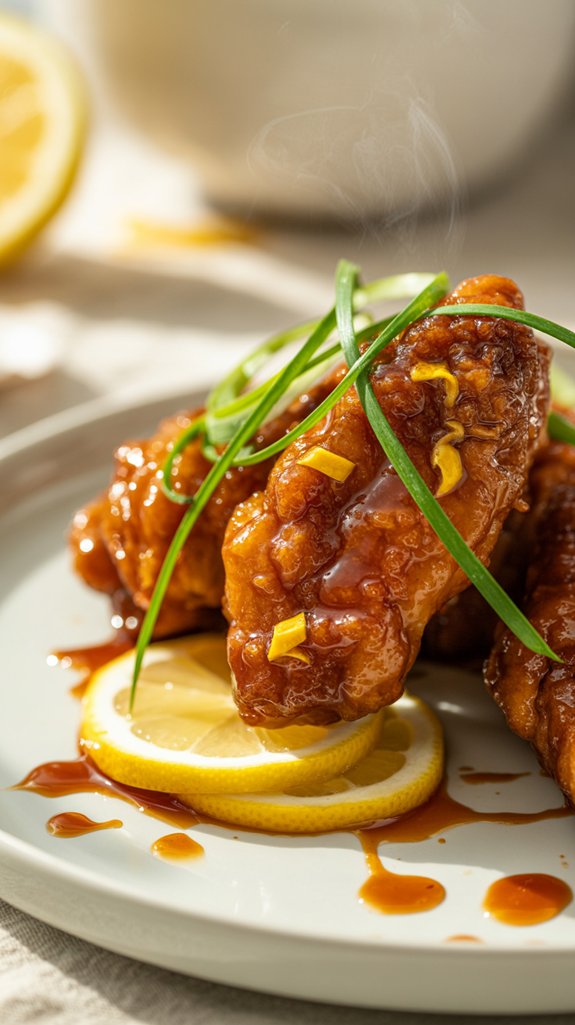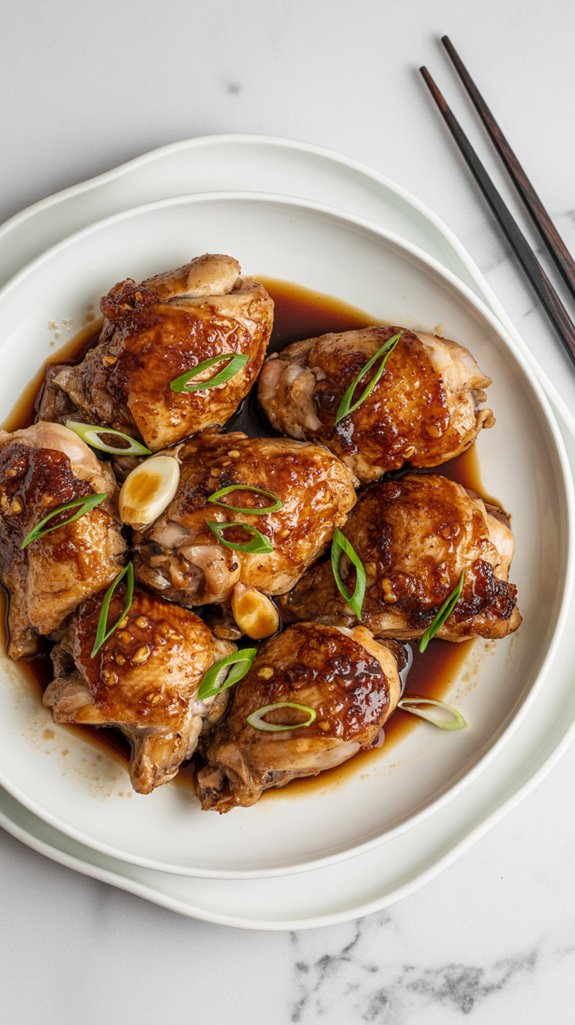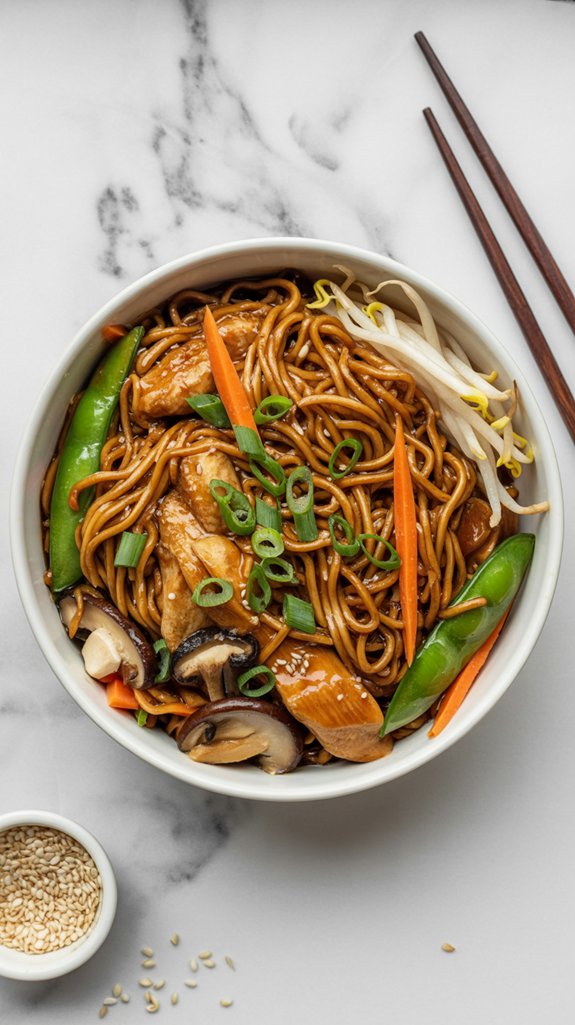Why You’ll Love This this Crispy Asian-Style Lemon Chicken
This double-fried chicken creates the most satisfying crunch you’ll ever hear, with that golden batter staying crispy even after you drizzle on the tangy lemon sauce.
The sweet and salty flavors hit all the right notes, kind of like takeout but without the mystery meat and questionable oil situation.
Plus, watching those lemon slices sizzle in the pan makes you feel like a real chef, even if you’re just following directions and crossing your fingers.
Ingredients List
Getting your ingredients together is the first step to crispy chicken perfection, and trust me, you don’t want to be scrambling around looking for cornstarch while your oil is heating up.
For the Chicken:
- 2 chicken breast halves
- 1 teaspoon salt
- 1 tablespoon light soy sauce (thin)
For the Batter:
- 1/2 cup flour
- 2 tablespoons cornstarch
- 1/8 teaspoon baking soda
- 1/4 teaspoon baking powder
- 1/4 teaspoon salt
- 1/4 teaspoon sugar
- 1/2 cup water (approximately)
- 1 tablespoon smoking hot vegetable oil
- Oil for deep frying
For the Lemon Sauce:
- 1 teaspoon salt
- 3 tablespoons sugar
- 1 tablespoon cornstarch
- 1 cup chicken stock
- 2 lemons, thinly sliced
- 1 scallion, shredded
Health Considerations:
- Deep frying means this isn’t exactly a health food, but you can feel better knowing you’re controlling the oil quality
- Fresh lemon slices pack vitamin C, which is something
- Chicken breast is lean protein, so there’s your silver lining
- The batter ingredients are pretty basic pantry staples, nothing too processed or scary
- You could theoretically bake this instead of frying, though it won’t be nearly as crispy and we both know that’s why we’re here
Step by Step Directions

Follow these steps carefully to achieve the perfect crispy coating and tangy lemon sauce that makes this dish restaurant-quality.
- Prepare the chicken: Season chicken breast halves with 1 teaspoon salt and 1 tablespoon light soy sauce, then set aside.
- Make the batter: Whisk together 1/2 cup flour, 2 tablespoons cornstarch, 1/8 teaspoon baking soda, 1/4 teaspoon baking powder, 1/4 teaspoon salt, and 1/4 teaspoon sugar in a bowl.
- Add liquid to batter: Gradually stir in approximately 1/2 cup water and 1 tablespoon smoking hot vegetable oil until batter reaches pancake batter consistency or slightly thicker.
- Coat and rest: Dip seasoned chicken in batter, ensuring complete coverage, then refrigerate for 10-15 minutes to help batter adhere.
- First frying: Heat oil to 350°F and deep fry battered chicken until lightly golden, then remove and drain.
- Rest between frying: Allow chicken to rest for at least 20 minutes before second frying.
- Second frying: Heat oil to 375°F and fry chicken again until crispy and golden brown, ensuring chicken is cooked through.
- Drain and slice: Blot chicken on paper towels to remove excess grease, then slice and arrange on serving platter lined with lettuce leaves.
- Start the sauce: Heat 1 teaspoon vegetable oil in a heavy skillet, add shredded scallion and stir for 30 seconds until sizzling.
- Add lemon: Stir in thinly sliced lemons for 1 minute until sizzling, being careful not to overcook or they’ll turn bitter.
- Finish sauce: Add 1 cup chicken stock, 1 teaspoon salt, 3 tablespoons sugar, and 1 tablespoon cornstarch, then cook for 5 minutes until thickened.
- Serve: Pour hot lemon sauce over sliced chicken and serve immediately while coating is still crispy.
While this recipe uses standard Western equipment, having the right cooking equipment set can make preparation easier and more authentic for Asian-style dishes.
Substitutions and Variations
• Spicy kick: Toss in some red pepper flakes with the lemon slices, or add a diced jalapeño to the sauce.
Just remember, you can always add heat but you can’t take it away.
• Vegetarian version: Cauliflower florets or firm tofu work surprisingly well with this batter and sauce combo.
The tofu needs to be pressed and cubed, while cauliflower should be cut into bite-sized pieces.
Additional Things to Serve With This Dish
This crispy lemon chicken deserves some serious sidekick support to make it a complete meal.
- Steamed jasmine rice – Because let me tell you, that tangy lemon sauce is basically liquid gold and you’ll want something to soak up every last drop. Plain white rice works too, but jasmine has that subtle floral thing going on.
- Stir-fried vegetables – Think broccoli, snap peas, or baby bok choy tossed with garlic and a splash of soy sauce. You need something green and crunchy to balance all that crispy, saucy goodness.
- Asian cucumber salad – Thinly sliced cucumbers dressed with rice vinegar, a pinch of sugar, and sesame oil. It’s invigorating and cuts through the richness like a champ.
- Egg fried rice – If you’re feeling fancy and want to go full takeout mode at home. Day-old rice works best here, trust me on this one.
- Simple lettuce wraps – Butter lettuce cups work perfectly for wrapping up pieces of the chicken with some rice. It’s like making your own little handheld parcels of joy.
- Steamed dumplings – Whether they’re pork, chicken, or vegetable, dumplings just make everything feel more like a proper feast. Plus, who doesn’t love an excuse to eat more dumplings?
Cooking Tips & Tricks (Chef’s Notes)
Let me share some game-changing secrets that’ll turn you from a lemon chicken amateur into someone who makes restaurant-quality magic happen in your own kitchen.
- Double-frying isn’t optional, it’s everything – I know it seems like overkill, but that first fry at 350°F cooks the chicken through while the second round at 375°F creates that shatteringly crisp coating that doesn’t go soggy the moment sauce hits it.
- Your batter needs to be thick enough to coat a spoon – Too thin and it slides right off the chicken, too thick and you get doughy clumps instead of that light, crispy shell we’re after.
- Refrigerate that battered chicken for at least 10 minutes – This little timeout helps the batter cling like it means business instead of floating away in the oil like some sad, separated mess.
- Watch those lemon slices like a hawk – The difference between beautifully caramelized and burnt-bitter disaster is about 30 seconds, and burnt lemons will make your whole sauce taste like regret.
- Room temperature chicken fries more evenly – Cold chicken straight from the fridge creates uneven cooking where the outside gets done way before the inside catches up.
- Don’t crowd the oil – Chicken pieces need their personal space to get properly golden, plus too much stuff in the pot drops the temperature and leads to greasy, pale results.
- Test your oil temperature with a wooden chopstick – Stick it in the oil and if bubbles form around it immediately, you’re ready to fry.
Nutritional Facts
This crispy lemon chicken delivers a satisfying balance of protein and flavor, though the double-frying method does add calories from the oil absorption.
- Calories per serving: Approximately 420-480 calories (based on 2 servings)
- Protein: 35-40 grams from the chicken breast, making this a high-protein meal
- Carbohydrates: 25-30 grams, primarily from the flour coating and cornstarch in the sauce
- Fat: 18-25 grams, mostly from the deep-frying oil absorption
- Sodium: High sodium content (800-1000mg) due to soy sauce, salt, and chicken stock
- Vitamin C: Good source from fresh lemon slices, providing immune system support
- Cholesterol: 70-85mg from the chicken breast
- Fiber: Minimal fiber content (1-2 grams)
- Sugar: 8-12 grams, mainly from the sauce’s added sugar and natural lemon sugars
- Iron: Moderate iron content from the chicken breast
- Calcium: Small amounts from the lemon and chicken stock
Fun “Did You Know?”
Beyond its nutritional profile, this beloved dish carries fascinating culinary secrets that’ll surprise even seasoned home cooks.
I’ve uncovered that double-frying chicken actually originated in Korean cooking techniques, creating that signature crispy texture we crave. The cornstarch-flour batter combination isn’t just random—cornstarch provides extra crunch while flour adds structure.
Here’s something amazing: adding hot oil to batter creates tiny air pockets, making it lighter. Those thinly sliced lemons? They’re meant to be eaten whole, providing bursts of citrus that complement the sweet-tangy sauce.
Most restaurants skip the double-fry step, which explains why homemade versions often taste superior.





